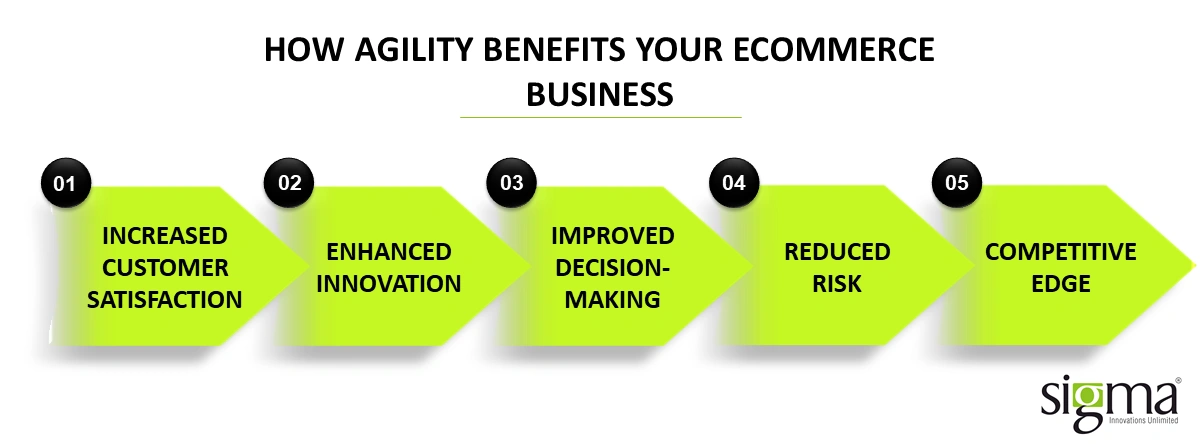Staying Agile in eCommerce with Changing Customer Behavior

The eCommerce landscape is a whirlwind of constant change. Remember when one-day shipping seemed like a luxury? Today, it’s table stakes. Customers are bombarded with choices, their expectations are ever-evolving, and new technologies emerge seemingly overnight. To survive, let alone thrive, in this dynamic environment, eCommerce businesses need to be agile.
This blog will guide you to stay nimble and adapt to your customers’ ever-changing whims. We’ll explore why agility is crucial, how to monitor customer behavior trends, and, most importantly, practical steps you can take to embrace flexibility and continuous improvement.
The Importance of Agility in eCommerce
Imagine a gazelle gracefully leaping across the savannah, effortlessly avoiding predators. That’s the kind of agility we’re talking about in eCommerce. It’s the ability to adapt quickly to changing circumstances, be responsive to customer needs, and continuously improve your offerings.
Why is this so important? Because the eCommerce world is anything but static. Technology advancements like voice assistants and augmented reality are revolutionizing the shopping experience. Customers have come to expect a seamless, personalized journey, and they’re not afraid to take their expectations elsewhere if they fall short. Plus, with new competitors popping up all the time, the pressure to differentiate yourself is immense.
Here’s how agility benefits your eCommerce business:

- Increased customer satisfaction: By responding quickly to feedback and preferences, you can create a shopping experience that truly delights your customers.
- Enhanced innovation: Agility allows you to experiment with new features and business models, keeping you ahead of the curve.
- Improved decision-making: A data-driven approach to monitoring customer behavior allows you to prioritize changes that will have the biggest impact.
- Reduced risk: By testing new features on a smaller scale, you minimize the risk of investing in something customers don’t want.
- Competitive edge: Agility allows you to respond faster to market shifts and competitor actions, keeping you one step ahead.
Monitoring Customer Behavior Trends
So, how do you stay on top of these ever-evolving customer desires? The key lies in monitoring customer behavior trends. By gathering data and analyzing it effectively, you can gain valuable insights into how your customers interact with your brand and what they expect from their shopping experience. Here are some powerful tools at your disposal:
- Website analytics: These tools track user journeys, identify pain points (like a confusing checkout process), and analyze purchase behavior (which products are most popular, and where customers are dropping off in the buying process).
- Customer surveys and feedback forms: Don’t underestimate the power of direct feedback! Surveys and forms provide valuable insights into customer preferences, frustrations, and suggestions for improvement.
- Social media listening: Social media platforms are a goldmine of customer sentiment. Listen to online conversations to understand brand perception and identify industry trends.
A/B testing: This technique allows you to experiment with different website elements (e.g., product descriptions, call-to-action buttons) and marketing campaigns to see which ones resonate best with your customers. - Heatmaps and session recordings: These tools provide visual data on how users interact with your website. You can see where they click, scroll, and hover, helping you identify areas for improvement.
Another critical piece of the puzzle is customer segmentation. By grouping customers based on demographics, purchase history, and browsing behavior, you can personalize the shopping experience. This could involve targeted advertising, product recommendations, or even email campaigns tailored to specific customer segments.
The Agile Mindset of Being Flexible to Adapt and Improve
Staying agile isn’t just about collecting data, it’s about fostering a culture of continuous improvement within your eCommerce business. Here are some key aspects to consider:
- Openness and Data-Driven Decisions: Encourage a culture where experimentation is encouraged, and decisions are based on data and customer insights, not gut feelings.
- Prioritizing Customer Feedback: Don’t let customer concerns and suggestions languish. Establish a system for quickly analyzing and addressing customer issues.
- Short Development Cycles: Implement agile methodologies like Scrum, which promote short development cycles and rapid releases of new features and updates. This allows you to test and adapt quickly based on customer feedback.
- Upskilling Your Team: Equip your team with the knowledge they need to understand customer behavior trends and adapt to new technologies. Invest in training and development programs.
Practical Tips to Put Agility into Action
Now that you understand why and how to monitor customer behavior, let’s get down to brass tacks. Here are some practical steps you can take to embrace agility in your eCommerce business:

- Create a Customer-Centric Roadmap: Analyze customer data and feedback to prioritize website improvements and feature additions. Focus on initiatives that will have the biggest impact on customer satisfaction and conversion rates.
- Leverage Automation: Repetitive tasks like sending abandoned cart emails or updating product inventory can be automated. This frees up your team’s time and resources to focus on strategic initiatives that require creativity and human touch.
- Optimize for Mobile Browsing: With the rise of mobile shopping, ensuring a seamless mobile experience is crucial. Optimize your website for mobile devices, prioritize fast loading speeds, and offer features like one-click checkout to make mobile shopping convenient.
- Personalization is Key: Customers crave a personalized shopping experience. Leverage customer data to personalize product recommendations, email marketing campaigns, and even website content. This makes customers feel valued and increases the likelihood of conversion.
- Stay Up-to-Date with Industry Trends: The eCommerce landscape is constantly evolving. Keep an eye on emerging technologies like artificial intelligence and augmented reality, and how they might impact customer behavior. Anticipate future needs and be prepared to adapt accordingly.
Conclusion
Agility isn’t just a buzzword; it’s a survival strategy in the dynamic world of eCommerce. By continuously monitoring customer behavior, fostering a culture of continuous improvement, and implementing the tips outlined above, you can ensure your business remains adaptable and responsive to ever-changing customer needs. Remember, agility isn’t a destination, it’s a journey. It’s about constantly learning, evolving, and staying ahead of the curve. By embracing this mindset, you’ll be well-positioned to thrive in the ever-changing eCommerce landscape.
But don’t go it alone! Building and maintaining an agile eCommerce platform requires expertise. At Sigma Infosolutions, a leading technology services company, we can help you with all your eCommerce needs, from development and maintenance to migration and re-platforming. Our team of experienced professionals can help you design, develop, and implement a future-proof eCommerce solution that scales with your business and keeps you ahead of the competition.
Visit our website to learn how we can help you build an agile and successful online store!

